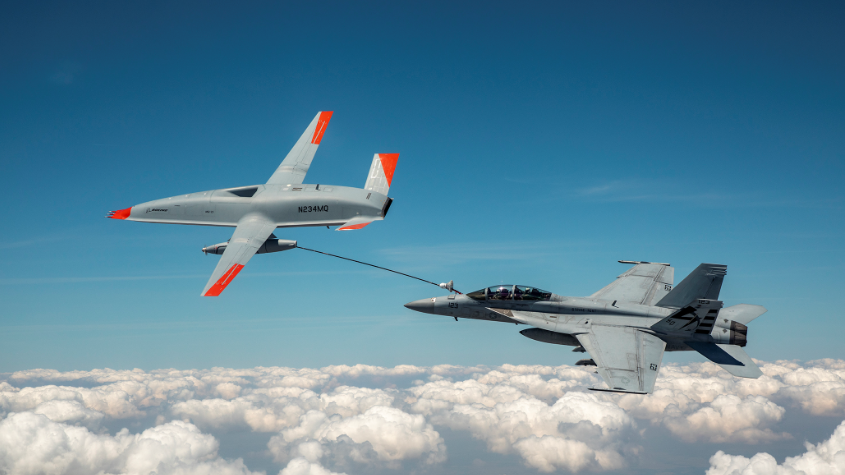
MQ-25 Stingray prototype T1 refuels an F/A-18F Super Hornet in mid-air for the first time. (Photo courtesy of US Navy)
WASHINGTON: A congressional budget cut from House lawmakers is threatening to delay the Navy’s plans to award an initial contract for the MQ-25 Stingray for a year, could mean operational squadrons won’t reach the fleet by a 2026 target, and will incur millions in extra costs over the life of the program, the Navy says.
The service warned House and Senate appropriators about the impending delays in a budgetary appeal document, obtained by Breaking Defense. The document outlines dozens of programmatic cuts made by lawmakers in their versions of the fiscal 2022 defense spending bill as well as Navy arguments to change course.
For the MQ-25, the Navy’s unmanned aerial tanker, the House Appropriations Committee recommended slicing off $47.5 million in advance procurement for long lead items that the president’s budget is seeking. The Senate Appropriations Committee recommended funding the program as requested.
“The proposed reduction will cause a one year delay to MQ-25A LRIP [low-rate initial production] contract award and directly result in the Navy not being able to stand up fleet squadrons to support FY26 operational deployments per the Navy’s Master Aviation Plan,” according to the document.
An LRIP contract is an important milestone for any major acquisition program, providing the green light for the prime contractor to begin mass manufacturing of a vehicle or product.
Navy spokeswoman Jamie Cosgrove told Breaking Defense even if the cuts survive Congress, it would not effect the program’s FY25 initial operational capability goal.
The MQ-25, being developed by Boeing, is designed to relieve the F/A-18 Super Hornet fleet from the aerial refueling mission, and by extension free up some of the service’s strike fighters for other tasks. For several years now, the Navy has grappled with ways to simultaneously increase the number of Super Hornets available for operations and reduce the numbers needed for refueling.
The service’s time estimates for fixing the strike fighter shortage have fluctuated. Former Navy acquisition executive Hondo Geurts once told lawmakers it may take until 2029, while Chief of Naval Operations Adm. Michael Gilday earlier this year claimed it would be as soon as 2025.
Since the contract award to Boeing in 2018, Navy leadership, including then-Chief of Naval Operations Adm. John Richardson, have stressed the need to bring MQ-25 to the fleet as quickly as possible. But the Navy is warning lawmakers that cutting funding now may result in a much steeper price to pay later.
“Additionally, the program will incur a $250-300M increase over the MQ-25A life of production due to the one-year delay, increasing risk to the supply base, re-qualification of components and subsystems, obsolescence, and potential redesign,” according to the Navy appeal document.
The Boeing MQ-25 test plane, dubbed T1, has been at the center of the service and company’s early testing and development plans. The Navy in its appeal states T1 thus far has completed refueling demonstrations with an F/A-18, E-2D and F-35C.
Further, the service is currently planning to bring T1 onboard the aircraft carrier George H.W. Bush (CVN 77) in December 2021, according to the document. That will be a critical test for the program because it will be the climax of Navy efforts to outfit its carriers with the necessary equipment to operate MQ-25 and other unmanned platforms.
“The Department urges support for the Senate position,” the document concludes.
Multi-ship amphib buy could net $900M in savings, say Navy, Marine Corps officials
Lawmakers gave the Navy authorities to ink a multi-ship amphib deal years ago, but the service has not utilized that power yet.


























